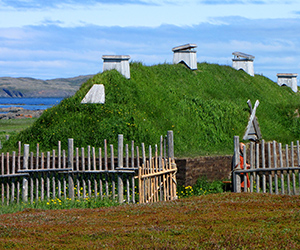CANADA HISTORY - War
The Invasion

Towards the closing days of World War II, as the tide turned decisively against the Axis powers, the Soviet Union made a critical move in the Pacific theater. Following their agreement with the United States and Britain at the Yalta Conference, the Soviets declared war on Japan in August 1945, just as the Japanese empire was crumbling under the weight of Allied victories. The Soviet objective was clear: to seize strategic Japanese-held territories on the Asian mainland, including Manchuria and the Korean Peninsula. This action, while part of the final push to defeat Japan, had significant implications for the postwar political landscape, particularly as the Cold War began to cast its long shadow over global affairs.
The Korean Peninsula, a region long dominated by Japan, quickly became a flashpoint in the ideological battle between the Soviets and the Americans. In the chaotic aftermath of Japan's surrender, the Allies agreed to a temporary division of Korea, ostensibly to facilitate the surrender of Japanese forces. The 38th parallel was chosen as the dividing line, with Soviet forces occupying the North and American forces occupying the South. Initially, this division was intended to be a short-term administrative solution. However, as the Cold War deepened, the divide solidified into a permanent geopolitical rift. Each superpower moved swiftly to install their preferred leaders in their respective zones of influence, setting the stage for the creation of two rival Korean states.
In the North, Kim Il Sung, a former guerrilla fighter who had gained favor with the Soviets, was installed as the leader of what would become the Democratic People’s Republic of Korea (DPRK). Backed by Soviet military and political support, Kim set about building a formidable military force. By 1950, the Korean People’s Army (KPA) boasted around 135,000 troops, heavily equipped with Soviet-made tanks, artillery, and other modern weaponry. Soviet advisors played a key role in training and organizing Kim’s army, ensuring that the North Korean military was prepared for offensive operations.
In contrast, South Korea struggled to establish political and military stability. The United States, focused on containing communism globally, supported the election of Dr. Syngman Rhee as the first president of the Republic of Korea (ROK) in 1948. Rhee, a staunch anti-communist, faced enormous challenges in consolidating power. The South was plagued by communist guerrilla activity, economic instability, and political turmoil. Rhee’s government, with American support, took aggressive measures to suppress leftist elements, but the situation remained precarious. Unlike the North, the South was poorly equipped and lacked the military resources necessary to defend itself against a determined external attack.
Meanwhile, in China, the balance of power was shifting dramatically. In 1949, Mao Zedong’s communist forces decisively defeated the Nationalist armies of Chiang Kai-shek, forcing them to retreat to the island of Taiwan. The victory of Mao’s People's Liberation Army in the Chinese Civil War shocked the West and heightened fears of a communist takeover across Asia. In the United States, policymakers began to ask, “Who lost China?” The fall of the world’s most populous country to communism was seen as a significant setback in the Cold War, leading to a reevaluation of American foreign policy in Asia.
Amid this backdrop of communist victories and Western uncertainty, North Korea—backed by both Soviet and Chinese leaders—began to contemplate an audacious move: the invasion of South Korea. The leadership in Moscow and Beijing calculated that the United States, still reeling from the loss of China and reluctant to commit ground forces in Asia, might hesitate to intervene. They believed that a swift, decisive strike by North Korean forces could overwhelm the South before the West could mount an effective response. The Soviets, under Joseph Stalin, provided the necessary military equipment and strategic guidance to Kim Il Sung, who eagerly prepared his forces for the offensive.
 On June 25, 1950, the North Korean army launched a surprise attack, pouring across the 38th parallel with 10 Soviet-equipped divisions. The KPA moved with lightning speed, utilizing their overwhelming advantage in tanks and artillery to shatter the poorly prepared South Korean defenses. Within days, the North Korean forces had captured Seoul, the South Korean capital, on June 27. The fall of Seoul was a devastating blow to the Rhee government, which fled southward in disarray as the North Koreans continued their relentless advance. By early July, the South Korean forces, along with hastily deployed American troops, were retreating towards the Pusan Perimeter, a last defensive line in the southeastern corner of the peninsula.
On June 25, 1950, the North Korean army launched a surprise attack, pouring across the 38th parallel with 10 Soviet-equipped divisions. The KPA moved with lightning speed, utilizing their overwhelming advantage in tanks and artillery to shatter the poorly prepared South Korean defenses. Within days, the North Korean forces had captured Seoul, the South Korean capital, on June 27. The fall of Seoul was a devastating blow to the Rhee government, which fled southward in disarray as the North Koreans continued their relentless advance. By early July, the South Korean forces, along with hastily deployed American troops, were retreating towards the Pusan Perimeter, a last defensive line in the southeastern corner of the peninsula.
The North Korean invasion sent shockwaves through the international community. The United States, shocked by the brazen attack, moved quickly to respond. President Harry Truman, already committed to the policy of containment, saw the invasion as a direct challenge to American resolve and the broader Western effort to contain the spread of communism. If the West allowed South Korea to fall, it would signal to the world that communist expansion could proceed unchecked. Truman, determined to uphold the principles of collective security as established by the United Nations, moved swiftly to secure international support for a military intervention.
 In a stroke of geopolitical fortune, the Soviet Union, which had been boycotting the United Nations Security Council over the refusal to seat the People’s Republic of China as the legitimate government of China, was absent when the United States introduced a resolution condemning North Korea’s aggression. Without the Soviets present to exercise their veto, the resolution passed, and the UN authorized the creation of a UN military force to defend South Korea. This decision was pivotal, as it legitimized the international effort to repel the communist invasion and set the stage for a multinational coalition to intervene on behalf of the Republic of Korea.
In a stroke of geopolitical fortune, the Soviet Union, which had been boycotting the United Nations Security Council over the refusal to seat the People’s Republic of China as the legitimate government of China, was absent when the United States introduced a resolution condemning North Korea’s aggression. Without the Soviets present to exercise their veto, the resolution passed, and the UN authorized the creation of a UN military force to defend South Korea. This decision was pivotal, as it legitimized the international effort to repel the communist invasion and set the stage for a multinational coalition to intervene on behalf of the Republic of Korea.
The United States, as the principal military power in the coalition, quickly mobilized its forces. General Douglas MacArthur, who commanded the U.S. occupation forces in Japan, was tasked with organizing the defense of South Korea. The first American unit to arrive in Korea was the 24th Infantry Division, hastily dispatched from Japan. They were soon joined by the 1st Cavalry and the 25th Infantry Division, but these forces were understrength, ill-prepared for the scale of the North Korean assault, and lacked the necessary equipment to halt the enemy’s advance. Despite their best efforts, the American and South Korean forces were driven back to the Naktong River, where they established a desperate defensive line around the port city of Pusan. This area, known as the Pusan Perimeter, became the last stand for UN forces on the peninsula.
 The situation in the summer of 1950 was dire. The North Koreans seemed unstoppable, and the UN forces found themselves outnumbered and outgunned. Yet, the Pusan Perimeter held, thanks in part to the strategic advantage of the Naktong River, which acted as a natural barrier, and the arrival of reinforcements and supplies from the United States. American air power, naval support, and the sheer determination of the defenders turned the tide of the war. Over the coming months, as more UN troops arrived, the stalemate around Pusan would be broken by MacArthur’s audacious Inchon landing, but in the early weeks of the war, the survival of South Korea hung in the balance.
The situation in the summer of 1950 was dire. The North Koreans seemed unstoppable, and the UN forces found themselves outnumbered and outgunned. Yet, the Pusan Perimeter held, thanks in part to the strategic advantage of the Naktong River, which acted as a natural barrier, and the arrival of reinforcements and supplies from the United States. American air power, naval support, and the sheer determination of the defenders turned the tide of the war. Over the coming months, as more UN troops arrived, the stalemate around Pusan would be broken by MacArthur’s audacious Inchon landing, but in the early weeks of the war, the survival of South Korea hung in the balance.
The Korean War thus began as a rapid and brutal confrontation, a flashpoint in the broader Cold War that reflected the fierce ideological battle between communism and democracy. The conflict would soon become a protracted and bloody stalemate, but in the summer of 1950, it was the North Korean blitzkrieg, backed by Soviet arms and communist ambition, that pushed the world to the brink of a much larger war.
Cite Article : Reference: www.canadahistory.com/sections/documents/documents.html
Source: NA



